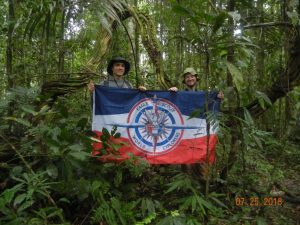 by Evan Dann
by Evan Dann
This summer Evan Dann participated in the 2018 NESA World Explorer Program. One of twelve Eagle Scouts selected, he traveled to Ecuador and the Yasuni National Reserve’s Tiputini Biodiversity Research Station. The following is an abbreviated version of his 24 page photo essay submitted to Dr. Michael Manyak and managers at National’s NESA World Explorer Program leadership.Evan is a Scouter registered with Troop 1023 in Kemptown, MD as well as a Sea Scout with Ship 59 in Frederick, MD. He is a merit badge counselor at FSK District Camp Airy. Currently, Evan studyies Biomedical Engineering at Boston University.
In my troop, going on a Philmont trek is something to which every scout looks forward and something that completes one’s scouting experience. I went to Philmont when I was 15, the summer just before earning my Eagle Scout award. After finishing both of these experiences, I thought that my scouting career was complete. However, earning my Eagle was the beginning of the most amazing scouting expedition I had yet to experience, and one that I would only discover existed several years after earning this premier scouting award.
This past summer I had the opportunity through the National Eagle Scout Association (NESA) World Explorer’s program to travel to Ecuador with another scout, Gabriel Burgos, where we spent a week deep in the remote Ecuadorian Amazon at the Tiputini Biodiversity Station (TBS). It takes a full day of travel to get from Quito, the capital of Ecuador to TBS. First, we flew over the Andes mountains to Coca, a city that lies on the Napo river in the Amazon. Next, we took a motorized canoe down the Napo river for about 2 hours. At the end of this leg in the journey, we travelled by bus over the oil concession about 60 km to reach the Tiputini river where we got on another motorized canoe for 2 hours and finally reached TBS. It is truly a remote place that is situated in a pristine rainforest.
We learned about the studies they do at the research station using motion sensitive camera traps. TBS mounts anywhere between twelve to fifty camera traps in the forest hoping to capture images of more elusive or nocturnal animals – such as armadillos, ocelots, jaguarundi, and jaguars. Specifically, the researchers use the camera traps to track individual jaguars to better understand the animal’s home range. Since jaguars live alone, the size of their range is not currently known. The photo information plays a key role in understanding a jaguar sighting in a particular area, and how deforestation impacts this apex predator. Gabriel & I set up our own two camera traps under the supervision of Diego, the TBS manager. Our goal was to help the station find answers to some of these questions.
While we were at TBS, we also had the opportunity to explore different parts of the forest. Each day, we would follow our machete wielding guide and go hiking to look for animals – some mornings we climbed the observation tower before sunrise for bird watching, some days we went trekking through the Amazonian swamps looking for capuchin monkeys, and other days we went fishing for piranhas in the Tiputini river. When we were tracking a group of peccaries through the forest, we tried to get close enough to get photos. However, as we approached, it became apparent that we were actually following white-lipped peccaries who travel in large packs. We could hear them feeding, breathing and snorting all round us but due to the dense vegetation, we couldn’t see them. Suddenly, there was complete silence in the forest indicating that the pack was lining up and preparing a defensive charge. Our guide immediately directed us to quickly run back up the trail to escape the charging peccaries!
We enjoyed dining in the outdoor pavilion where all our meals were served. I really enjoyed eating here because while we were covered under the pavilion, the sounds of the forest surrounded us, so I never lost a sense for how special it was to be in the forest. I particularly looked forward to eating dinner since by that time, it was dark and the bats would by flying all around the pavilion chasing mosquitos and other insects. Mealtimes were also a chance to network with the visiting scientists. We were fortunate to interact with an international group of primatologists studying the 11 different species of monkeys found at TBS.
Just like you never forget the stories you have from Philmont, Gabriel and I have incredibly unique stories that we will never forget. I am grateful and honored to have experienced the Tiputini Biodiversity Station. This is an opportunity for which all Eagle Scouts are eligible and I strongly encourage you to apply at www.NESA.org.

